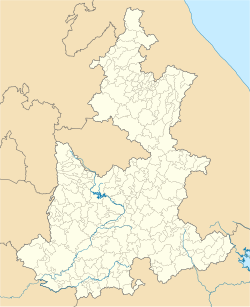 | |
| Location | Cholula de Rivadabia, Puebla, |
|---|---|
| Region | Puebla |
| Coordinates | 19°03′27″N 98°18′07″W / 19.05750°N 98.30194°W |
| History | |
| Periods | Classic to Postclassic |
| Site notes | |
| Architecture | |
| Architectural styles | Talud-tablero |
| Architectural details | Number of temples: 1 |
| Responsible body: Instituto Nacional de Antropología e Historia | |
The Great Pyramid of Cholula, also known as Tlachihualtepetl (Nahuatl for "constructed mountain"), is a complex located in Cholula, Puebla, Mexico. It is the largest archaeological site of a pyramid (temple) in the world, as well as the largest pyramid by volume known to exist in the world today.[1][2] The adobe brick pyramid stands 25 metres (82 ft)[3] above the surrounding plain, which is significantly shorter than the Great Pyramid of Giza's height of 146.6 metres (481 ft), but much wider, measuring 300 by 315 metres (984 by 1,033 ft) in its final form,[3] compared to the Great Pyramid's base dimensions of 230.3 by 230.3 metres (756 by 756 ft).[4] The pyramid is a temple that traditionally has been viewed as having been dedicated to the god Quetzalcoatl.[5] The architectural style of the building was linked closely to that of Teotihuacan in the Valley of Mexico, although influence from the Gulf Coast is evident as well, especially from El Tajín.[6]
- ^ Coe & Koontz 1962, 2002, p. 120.
- ^ The giant pyramid hidden inside a mountain, BBC News, retrieved on August 15, 2016
- ^ a b Culture (15 August 2010). Kuiper, Kathleen (ed.). Pre-Columbian America: Empires of the New World. The Rosen Publishing Group, Inc. p. 42. ISBN 978-1-61530-150-8. Retrieved 6 May 2022.
- ^ "8 Largest Pyramids in the World (with Photos & Map)". www.touropia.com. Touropia. 9 June 2010. Retrieved 2018-05-28.
- ^ Coe & Koontz 1962, 2002, p. 121.
- ^ Davies 1982, 1990, p. 92.

